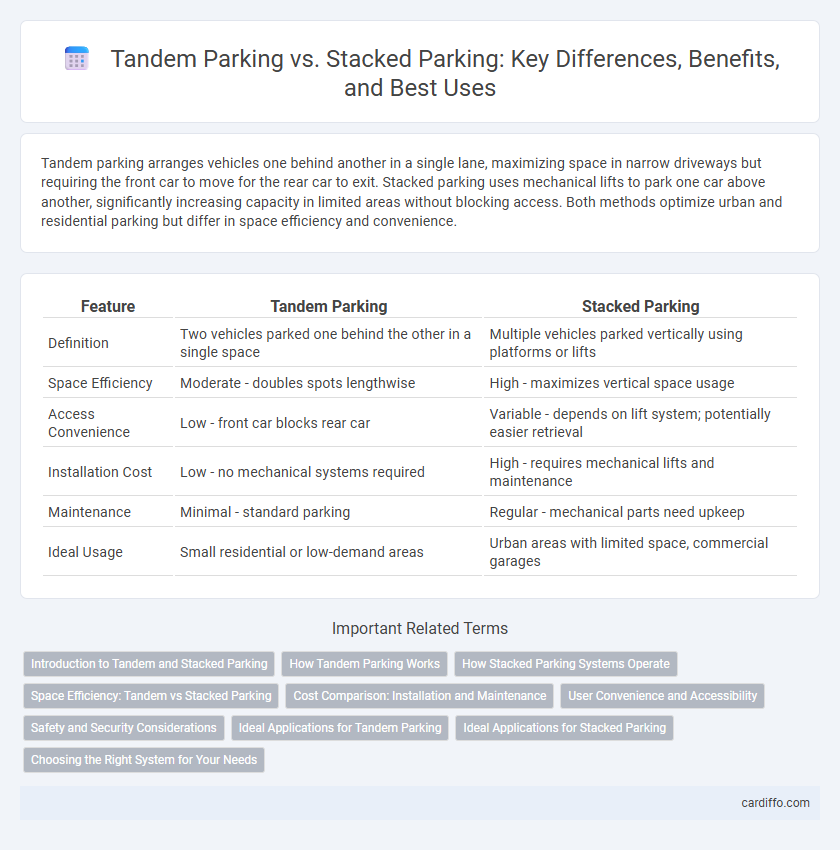Tandem parking arranges vehicles one behind another in a single lane, maximizing space in narrow driveways but requiring the front car to move for the rear car to exit. Stacked parking uses mechanical lifts to park one car above another, significantly increasing capacity in limited areas without blocking access. Both methods optimize urban and residential parking but differ in space efficiency and convenience.
Table of Comparison
| Feature | Tandem Parking | Stacked Parking |
|---|---|---|
| Definition | Two vehicles parked one behind the other in a single space | Multiple vehicles parked vertically using platforms or lifts |
| Space Efficiency | Moderate - doubles spots lengthwise | High - maximizes vertical space usage |
| Access Convenience | Low - front car blocks rear car | Variable - depends on lift system; potentially easier retrieval |
| Installation Cost | Low - no mechanical systems required | High - requires mechanical lifts and maintenance |
| Maintenance | Minimal - standard parking | Regular - mechanical parts need upkeep |
| Ideal Usage | Small residential or low-demand areas | Urban areas with limited space, commercial garages |
Introduction to Tandem and Stacked Parking
Tandem parking involves parking two vehicles in a single elongated space, one behind the other, maximizing space in narrow or limited areas. Stacked parking uses vertical lifts or platforms to park multiple cars in the same footprint, increasing capacity in urban environments. Both methods optimize space efficiency by accommodating more vehicles within a constrained parking area.
How Tandem Parking Works
Tandem parking arranges vehicles one behind another in a single parking space, requiring drivers to park or exit sequentially. This system optimizes narrow or limited parking areas, allowing two cars to share a spot by coordinating movement. Efficient use of tandem parking demands careful scheduling to prevent blocking and ensure smooth access for all vehicles.
How Stacked Parking Systems Operate
Stacked parking systems utilize vertical lifts to park one vehicle above another, maximizing space in compact areas. These mechanized platforms operate via hydraulic or electric lifts, enabling efficient vehicle retrieval without requiring additional floor space. This system increases parking capacity by effectively doubling the number of cars parked in the same footprint compared to tandem parking.
Space Efficiency: Tandem vs Stacked Parking
Tandem parking arranges vehicles in a single file, maximizing linear space but potentially limiting individual car accessibility. Stacked parking uses mechanical lifts to park cars vertically, significantly increasing space efficiency by doubling or tripling vehicle capacity within the same footprint. Both methods optimize urban parking where horizontal space is limited, with stacked parking offering superior density in multi-level structures.
Cost Comparison: Installation and Maintenance
Tandem parking typically incurs lower installation costs due to simpler structural requirements compared to stacked parking systems, which need mechanical lifts and reinforced supports. Maintenance expenses for stacked parking tend to be higher as regular servicing of lifts and electronic components is essential to ensure operational safety and reliability. Tandem parking's mechanical simplicity results in reduced long-term upkeep costs, making it a cost-effective choice for many residential and commercial properties.
User Convenience and Accessibility
Tandem parking allows two vehicles to be parked one behind the other, requiring the front car to move first for the rear car to exit, which can limit user convenience and accessibility. Stacked parking uses mechanical lifts to park vehicles vertically, maximizing space while providing individual access to each car without moving others, enhancing user convenience. Both systems optimize space, but stacked parking offers superior accessibility and ease of use in constrained urban environments.
Safety and Security Considerations
Tandem parking allows two vehicles to park one behind the other in a single lane, which can limit maneuverability and increase the risk of collisions when accessing the rear vehicle. Stacked parking systems, often mechanical lifts, enhance security by restricting access to vehicles and reducing the likelihood of theft or vandalism. Both options require careful design to ensure safe entry and exit while maximizing space efficiency in parking facilities.
Ideal Applications for Tandem Parking
Tandem parking spaces are ideal for residential properties, such as townhouses and duplexes, where maximizing limited driveway or garage space is crucial. These configurations work well in narrow lots or urban environments where extending the parking area is constrained. Tandem parking enhances vehicle capacity without compromising walkway or landscape space, making it suitable for multi-car households or shared parking setups.
Ideal Applications for Stacked Parking
Stacked parking is ideal for urban areas with limited space, such as residential complexes and commercial buildings where maximizing the number of parking spots is crucial. It suits locations with low turnover rates, making it perfect for long-term parking scenarios like office buildings, hotels, and multi-family housing. This system enhances parking efficiency by allowing multiple vehicles to occupy a single space vertically without requiring additional land.
Choosing the Right System for Your Needs
Tandem parking maximizes space by parking vehicles one behind another, ideal for residential or small commercial properties with limited depth but enough length, while stacked parking uses mechanical lifts to park cars vertically, leveraging height to significantly increase capacity in multi-level structures. Selecting between tandem and stacked parking depends on factors such as available space dimensions, vehicle turnover frequency, budget constraints, and maintenance requirements. Prioritizing efficiency, convenience, and long-term operational costs will guide the optimal choice for your specific parking needs.
Tandem parking vs stacked parking Infographic

 cardiffo.com
cardiffo.com